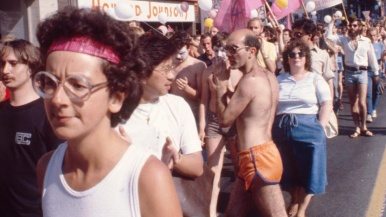The 10 biggest moments in comedy in the last 50 years
To celebrate Toronto Life’s 50th year, we’re counting down the biggest Toronto moments of the last half-century. This month: a ranking of the comedians, punchlines and clubs that mattered most. Disagree with our choice for number one? Have your say at the bottom

MOVE OVER, BOYS 2016
Samantha Bee goes global
10 When Samantha Bee graduated from Toronto’s all-girl sketch troupe the Atomic Fireballs, she landed a dream job: correspondent on The Daily Show With Jon Stewart. She spent 12 years there, perfecting a ferocious wit that made her a favourite to replace Stewart. Instead, like so many of the series’ alumni (John Oliver, Stephen Colbert), Bee branched out to start her own late-night political satire, Full Frontal. The show is fierce, funny and sharp, and it regularly outshines that of Stewart’s official successor, Trevor Noah.

SCARBOROUGH’S FAVOURITE SON 1992
Wayne’s World revealed Mike Myers’s not-so-secret love for Toronto
9 Every inch of Myers’s career is steeped in his hometown: the SNL-skit-turned-hoser-fave Wayne’s World, which made Myers the most sought-after comedian of the day, was sourced from his teenage years. Every Austin Powers film has a reference to the Maple Leafs. And last year, Myers dropped by SNL wearing a Leafs jersey. Today, there’s a street near Lawrence and Kennedy called Mike Myers Drive.

AMERICAN MOCKERY 2001
Rick Mercer’s escapades south of the border
8 In the late 1990s, CBC’s satirist-in-chief Rick Mercer started stomping around city streets and state capitol buildings, convincing Americans to congratulate Canada on legalizing VCRs, applaud the bombing of Saskatchewan and protest our tradition of casting off our senior citizens on ice floes. “Talking to Americans” was an instant hit on This Hour Has 22 Minutes and earned its own hour-long special in 2001 (2.7 million viewers tuned in). It established a trusty brand of Canadian comedy: mocking our big, self-obsessed neighbour to the south.

RUSSELL PETERS RISES 2004
A viral video launched Canada’s most successful stand-up comic
7 One day in 2004, an obscure Indo-Canadian’s Comedy Now! special found its way onto YouTube. For weeks afterward, you couldn’t go anywhere in the city without hearing “Somebody’s gonna get a hurt real bad”—Peters’s hilarious impression of his disciplinarian dad. The Brampton-raised comic was irreverent and offensive, and he riffed on multiculturalism in a way no Canadian ever had.

THE LITTLE COMEDY CLUB THAT COULD 1976
The birth of Yuk Yuk’s
6 In the spring of 1976, Mark Breslin, Harbourfront Corp.’s ex–theatre and music director, gathered a half-dozen of his funniest friends, packed them into the basement of the 519 Church Street Community Centre and called it a comedy club. Admission was $1, and a janitor regularly crashed the party at closing time, screaming, “Get out! It’s 11 o’clock!” Yet the shows were a hit, and the weekly series continued at the 519 for four years, welcoming budding comics like Jim Carrey, Howie Mandel and Rick Moranis. Today, there are Yuk Yuk’s clubs in 17 cities across the country.

THE CULT FAVOURITE QUINTET 1988
The Kids in the Hall introduced an absurd brand of funny
5 After Lorne Michaels saw the Kids in the Hall perform at the Rivoli, he recruited Bruce McCulloch and Mark McKinney to write for SNL before realizing that removing any members ruined the magic. He reunited the troupe in Toronto, got CBC and HBO onboard, and let the 20-something clowns run wild with their most out-there ideas (“I’m crushing your head!”). Their screwball sketch show evoked the best of Monty Python and SCTV, injected CBC with a sense of humour, and proved Canadian comedians didn’t need to move south to succeed.

THE YEAR OF THE FLOOD 1994
365 zany days in which Jim Carrey was everywhere
4 1994 belonged to Jim Carrey. In less than 12 months, the wackiest prankster to hail from the GTA went from “token white guy” on In Living Color to A-list movie star, with leading roles in low-budget hit Ace Ventura: Pet Detective, special-effects laugher The Mask and idiotic masterpiece Dumb and Dumber. The very next year, Columbia Pictures paid Carrey $20 million—a record at the time and more than 50 times what he made for Ace Ventura—to lend his talents to The Cable Guy.

TORONTO’S TROUPE 1973
Second City and the CanCon comedy explosion
3 Chicago’s Second City improv troupe invaded Hogtown in 1973 and transformed local comics into national icons. Their revues were the most side-splitting in town. Their television adaptation, SCTV, became one of the funniest shows Canada has ever produced. And their wittiest members graduated to Hollywood (Martin Short, Rick Moranis, Harold Ramis, Andrea Martin, Catherine O’Hara).

THE SLAPSTICK PIONEERS 1969
Wayne and Shuster, original yuksters
2 Johnny Wayne and Frank Shuster performed overseas for Canadian troops during WWII and landed a show in the early days of CBC Television. Their wholesome skits—like a baseball game in Shakespearean English—were perfect for the post-war era. By 1969, they’d appeared on the Ed Sullivan Show 67 times, more than any other performer.

SATURDAY NIGHTS NEW KING 1975
Lorne Michaels launched an empire of laughs
1 When NBC resolved to steal Saturday night viewers from ABC, they called Lorne Michaels, a 30-year-old goofball from Forest Hill who had written zingers for Lily Tomlin and produced satire for the CBC. His master plan was a high-energy, 90-minute, live variety show. Since then, SNL has produced some of the world’s biggest comedians and actors (including Martin Short and Mike Myers), and Michaels himself has overseen four decades of big- and small-screen super-hits, from Mean Girls to 30 Rock to Portlandia.





